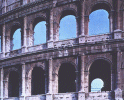Roman Architecture |
Roman Architecture |
| The Colosseum, (Flavian Amphitheater) Rome, begun 69 CE |
|

 |
Although amphitheaters were built throughout the Roman Empire, none are as grand and large as this. A significant example of the architecture of leisure and entertainment, it provided good visibility for the over 50,000 spectators. They viewed animal games, spectacles, and gladiatorial combats there. Begun in the 1st century CE by Vespasian, a member of the Flavian family, it remained in use until the early sixth century. |

 both: MAS |
The exterior borrows from Greek architectural orders. From the bottom to the top, the columns are Doric, Ionic, and Corinthian with Corinthian pilasters at the top register. The Roman arch, however, is the dominant structural and design detail. |


 center & right: MAS |
The design of the Colosseum is a triumph of functional planning. With numerous exits and entrances, it could easily accommodate crowds. The modern football stadium borrows from this design. Spectators were seated by rank with the topmost seats, the "chicken coop," available for women and children. Most of the seats are gone today. An awning originally covered the whole. The basement level, now exposed, was covered with a wooden floor which was strewn with sand (Latin "arena," the source of the English word "arena"). In the basement were elaborate corridors, elevators, gladiatorial barracks, and rooms for wild beasts. |
|
The Pantheon Rome, 118-125 |
|


| Dedicated to all the gods ("pan" means all and "theos" means gods), the Pantheon is one of the greatest architectural achievements of all time. Although the architect is unknown, the design is very original. The building has survived because it was converted to a Christian church in 7th century. |

 |
The exterior has a deep porch, almost like a temple itself with columns dividing it as if it were a basilica. The interior has a circular plan with niches around the periphery. |

 |
Complex relationships make the interior rich and varied: horizontals and verticals, back and forth movements, various sizes and types of columns, and color harmonies. Colored granites, porphyry, and yellow and white marbles not only give the interior a luxurious effect but hide the understructure of brick and concrete.
But what most impressed later cultures was the huge dome (144 feet in diameter) with the 30 foot skylight. It is larger than that of St. Peter's in Rome, and made of poured concrete (5000 tons of it!). |
|
The Arch of Titus Rome, about 81 CE |
|


|
The Romans perfected the use of the arch in bridges and aqueducts, but the triumphal arch is not functional. These arches often replaced the old city gates, which had been defensive, and usually traffic did not pass through them except for special parades and processions. Costly and ostentatious, the structures became a symbol of the Empire. Superb propaganda, they advertised the glory of Rome. This kind of propagandistic architecture (usually glorifying military victory) was very influential on later cultures. The most impressive example is the Arc de Triomphe at the center of Paris.
At the summit of the Sacred Way, a street which connected the Forum and the Colosseum, the Arch of Titus has relief sculptures on the sides of the interior. In the image on the right, Titus' victory in the Jewish War (66-70 CE) is recorded in stone. The booty taken from the Temple in Jerusalem (the Menorah, the Table of Shrew Bread, and silver trumpets which called Jews to Rosh Hashana) is carried through the streets in triumph. |
|
The Arch of Constantine Rome, 312-15 CE | |
 |
Increasingly the triumphal arch came to be used not only to glorify the Empire but particular emperors as well. The Arch of Constantine is an even larger example of the type, with three arches instead of one. Adjacent to the Colosseum and well-preserved, it too exerted an influence on later architects. |
All images marked MAS were photographed on location by Mary Ann Sullivan. All other images were scanned from other sources or downloaded from the World Wide Web; they are posted on this password-protected site for educational purposes, at Bluffton College only, under the "fair use" clause of U.S. copyright law.